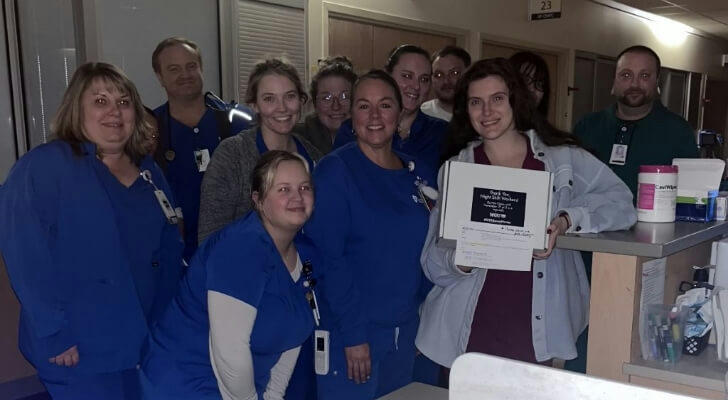Silent Guardians: How Night Shift Nurses Ensure Patient Safety
In the ever-operating environment of hospitals, night shift nurses stand out as silent guardians. They play a critical role in ensuring every patient receives thorough care and remains safe and comfortable during the night. The night shift requires not only high professional skills but also immense patience and meticulous observation. This article delves into the various efforts made by night shift nurses to ensure the safety and health of patients.

I. Responsibilities and Challenges of Night Shift Nurses
1. The Unique Night Shift Environment
Hospitals at night are quite different from their daytime counterparts. Dim lighting, silent corridors, and fewer available staff make the night shift exceptionally demanding. Night shift nurses must remain vigilant in such environments, observing subtle changes to ensure patient health. For example, a postoperative patient might wake from pain during the night, requiring the nurse to quickly assess the situation and provide necessary treatment.
2. Limited Personnel and Resources
During the night, hospital staffing and resources are often not as abundant as during the day. For instance, many specialists might be off-duty, requiring on-call notifications in emergencies. This limitation demands that night shift nurses have a strong ability to handle situations independently. They need to be adept with emergency medical equipment to ensure timely and effective intervention.
II. Core Strategies for Ensuring Patient Safety
1. Mastery of Professional Skills
Night shift nurses must possess extensive medical knowledge and adept nursing skills. They need to be ready at all times to handle various emergencies, including fluctuations in vital signs, medication side effects, or medical equipment malfunctions. For example, if a patient experiences cardiac arrest during the night, the nurse must immediately perform CPR and sustain the patient's vital signs until the emergency team arrives.
2. Accurate Information Recording and Handover
Accurate recording during shift handovers is crucial. Night shift nurses must comprehensively document each patient's care and treatment details to ensure seamless information transfer. For instance, if a patient is on a new treatment plan requiring specific medication doses and timing, this information must be accurately conveyed to the incoming shift to prevent treatment errors.
3. Regular Rounds and Close Monitoring
Night shift nurses conduct regular rounds to ensure every patient remains stable. This proactive approach helps capture any subtle physiological or psychological changes, addressing issues before they escalate. For example, during rounds, a nurse might notice a patient's IV has stopped or the drip rate is abnormal and can adjust the situation before it worsens.
4. Emergency Preparedness and Capability
A hospital's emergency plan plays a key role in patient safety. Night shift nurses are often the first responders in emergency situations and must understand procedures for crises like fires, power outages, or natural disasters. Taking effective measures to ensure patient safety is their responsibility, such as checking the battery status of life-support equipment during a power outage and relocating patients if necessary.

III. Communication with Patients and Families
1. Reducing Patient Anxiety
Many patients may feel anxious at night due to loneliness and unease. Nurses need to use effective communication to ease patients' tension. By explaining medical procedures and recovery plans, nurses can reduce misunderstanding and anxiety. For example, a patient awaiting a crucial test might feel terrified during the wait; the nurse can help alleviate this fear through detailed explanations about the procedure's safety and necessity.
2. Coordinating Communication with Families
In care delivery, communicating with patients' families about their loved one's progress and treatment plans is essential. Night shift nurses field inquiries from family members even at odd hours, updating them on the patient's condition. This communication must be both precise and patient, assisting families in providing psychological support.
IV. Technology and Innovation in Night Shift Nursing
1. Application of Modern Equipment
Hospitals increasingly use advanced technology to support nursing work, particularly at night, where precise data monitoring devices are crucial. For example, modern ECG monitors provide real-time heart rate tracking and connect with central systems through networks, enabling immediate access to the patient's status.
2. Introduction of Telemedicine and Artificial Intelligence
Remote monitoring systems and AI tools are gradually being integrated into hospitals. These technologies allow nurses to proactively access potential risk information from screens, taking preemptive measures. AI analysis can alert nurses in advance to a patient's risk of complications within hours, allowing preventative actions to be taken.

V. Psychological Adjustment and Work-Life Balance
1. Stress of Night Shift Work
Night shifts interfere with the natural circadian rhythm, which can lead to fatigue and health problems over time. Nurses need to employ strategies like yoga, meditation, exercise, and adequate sleep to manage stress. These activities help nurses recharge, maintain emotional stability, and perform at their best.
2. Balancing Work with Personal Life
Night shift nurses often seek to balance personal life and professional responsibilities. They carefully schedule rest periods to minimize disruption from night work, ensuring their health and family harmony. This balance improves their focus and commitment to patient care.
VI. Real-Life Case Analysis
Case: Handling a Sudden Postoperative Complication
One evening, a postoperative patient developed severe abdominal pain and confusion. A night shift nurse noticed the abnormality during rounds and quickly assessed the situation, finding significant abdominal tenderness and unstable vital signs. She immediately notified the on-call physician and initiated basic life support protocols, preparing emergency medications and equipment. The nurse's timely response and the physician's diagnosis allowed for a swift intervention, stabilizing the patient.
This case highlights the importance of quick reflexes, clinical judgment, and team collaboration of night shift nurses. With limited resources, the nurse identified and managed the situation effectively, ensuring patient safety.
VII. Future Trends and Challenges in Night Shift Nursing
1. Ongoing Staffing Shortages
There is a global shortage of nurses, especially for night shifts. To attract and retain talent, hospitals must improve working conditions, offer competitive wages, and provide better career development opportunities and support. These measures can reduce stress in night shift work and promote personal growth and professional advancement.
2. Innovation and Continuous Education
Future night shift nurses will face increasingly complex health issues requiring a broader skill set. This includes ongoing professional education and training to master the latest medical technology and nursing methods. Providing modern equipment and training empowers nurses to continually elevate their professional competence for better patient care.
VIII. Conclusion
Night shift nurses play an indispensable role in ensuring hospitals operate around the clock. Through their proficient skills, effective communication, and use of new technology, they consistently strive to provide high-quality care. Whether on quiet nights or during emergencies, they uphold high professional standards and a sense of duty. Society should recognize and appreciate their work value by offering better support and conditions, allowing night shift nurses to persistently safeguard patient safety. Through collective efforts, we can expect higher-quality care services and a safer healthcare environment.
